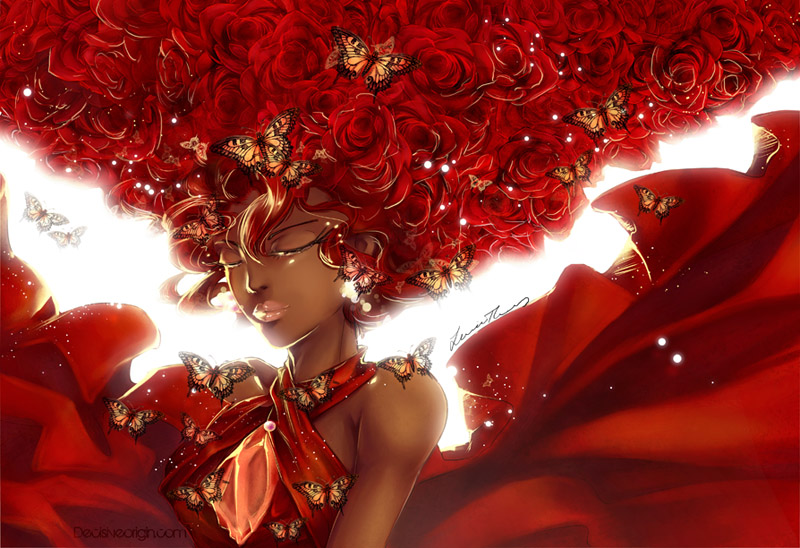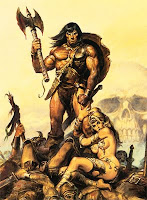
With so much going on lately, I’ve had little energy to write expansive blogs. My apologies for this! After I finish the last chapter of my book, I hope to come back to it with more informative blogging sessions getting back to some of the artists and technology topics discussed previously. I am also open for topic suggestions, if you have anything you’d like me to ponder about in the meantime.
For now, I leave you with a list of movies that make me want to draw. I’ve never been one to work in complete silence so there are always movies or music playing in the background. These particular movies give me a twinge of creativity, a tiny ache to draw something boundless.
1. What Dreams May Come
Much like Dante of the Divine Comedy, Robin William’s character embarks on a quest through the underworld to redeem the soul of his wife. I’ve been leaning a lot on this movie of late with its glimpses of shimmering heavenly cities, libraries floating amidst underworld rivers, and thought provoking philosophy. Every time I watch this movie, I find something new in the rich canvas of its imagery that I never saw before. Tear jerker warning for this one!
2. The Cell
The director of this movie admitted it really was like one big psychedelic music video. Using state-of-the-art technology, a child therapist ventures into the mind of a killer in order to find the location of a victim who may yet be alive! Though disturbing, there’s something about the mix of dark, gritty, and deeply symbolic imagery in this one that awes and fascinates me. The soundtrack to this one is also amazing with slight eastern undertones
3. Legend
I feel this movie is a prerequisite for many contemporary fantasy artists! With its classical tale of a beauty being taken to the Underworld, ethereal unicorns, and goblins who speak in couplets, what more could a fantasy fan want for imagery? The UK release of this film sports a completely different soundtrack and ending, but I still prefer the US version with its surreal soundtrack by Tangerine Dream. Oh yeah, and Tim Curry as the Devil! C’mon! (Wow and check out that epic trailer narration!)
4. Bram Stoker’s Dracula
The Francis Ford Coppola version. My favorite version of the classic vampire’s tale (and possibly my favorite Vampire movie of all time). With the wardrobe of Eiko Ishioka and heavy influence from the Symbolist movement of art, this movie is just mind-blowing sensory overload. Even more impressive is the fact they used classic film splicing and layering effects with no cg. Add to that Gary Oldman and Anthony Hopkins and you have a combination for win in my book!
5. Brotherhood of the Wolf
Gaudy sensuality, over the top action sequences, a Native American dude who inexplicably knows oriental martial arts. I can forgive this movie its flaws for its gorgeous wardrobe, interesting plot twists, and wonderfully surreal soundtrack. I love Monica Belluci’s wardrobe especially. Dark lace, razor sharp fans, corsets, and tarot cards. Mmm.
6. Vampire Hunter D: Bloodlust
From Ninja Scroll to X, I’ve always had a liking for the work of character designer and animation director Yutaka Minowa. Never are his designs more stunning and gothic than they are in Bloodlust. From D’s adornments to Leila’s combat jumpsuit, this movie is a character designers feast! Where else can you get a werewolf with a face in his stomach, a man who attacks with shadows, and a vampire hunting gang all in one movie? If you don’t watch it for the plot, watch it for the visuals.
7. Willow
I’m perhaps dating myself with this movie on the list. I love it for the same reason I love Legend, it’s fantastical visuals that aren’t quite sugary sweet fantasy. A group of unlikely heroes must protect a baby from an evil queen. Roguish heroes, wry humor, monsters, sorcery and more! It’s a fun and inspiring ride. Probably still my favorite thing that George Lucas has ever done, even over Star Wars.
8. The Lord of the Rings: Two Towers
This movie needs no introduction. I list Two Towers here because it is my favorite of the trilogy. The biggest treat for me in this one, visually, is the distinctive sets of armor we see in the Elves, Goblins & Uruk Hai, and the Men of Rohan. There’s also a more down to earth plot here in the epic fight of Helm’s Deep. It was far more epic with its human tale of fear than the epic fallout of Return of the King. I toss this movie on whenever I’m in the mood for martial inspiration.
9. Pan’s Labyrinth
Guillermo del Toro at his best. A little girl named Ofelia entertains flights of fantasy in the old labyrinth near her home, where she and her mother are prisoners to the whims of her mother’s lover, a violent military Captain. I love this movie for the way it walks a fine line between reality and fantasy. The creatures are never unbelievable, even if we are left questioning Ofelia’s hold on reality as she ventures deeper into forbidden places. The ‘Pale Man’ gives me the chills every time! There’s a fairy tale magic blended with the harsh realities of real life. It’s that blend that makes it the most compelling to my art muses.
10. Labyrinth
Another movie that needs no introduction. I grew up with its songs at the height of Jim Henson’s creativity. The Masquerade dream sequence,especially, gets my artistic gears going!
Wow, this entry didn’t turn out short at all did it? It’s amazing after compiling this how many of my inspiring movies deal with descending into otherworlds, underworlds, or dreams, though I am far from surprised by this revelation!
So what are your favorite inspiring movies? What gets your creative juices flowing?










